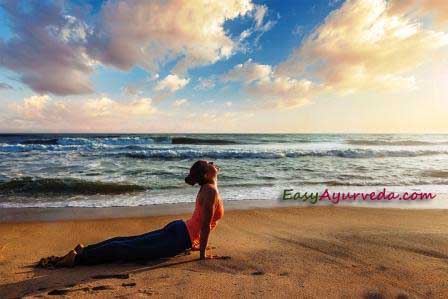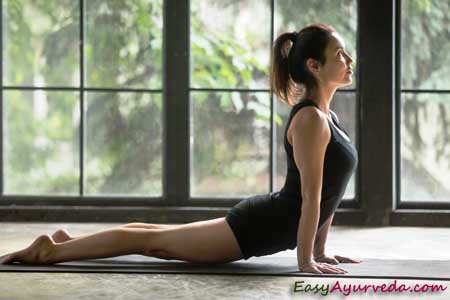Urdhva Mukha Svanasana – Upward Facing Dog Pose, How to do, Benefits
Article by Dr Raghuram Y.S. MD (Ay) & Dr Manasa, B.A.M.S
Adho Mukha Svanasana is an important Yoga Asana in which the performer needs to assume the pose of a dog facing and stretching upwards. Therefore, this asana is called Urdhva Mukha Svanasana or Upward Facing Dog Pose. This pose is almost similar to Bhujangasana with slight variations. It is also a Yoga backbend like Bhujangasana and is performed as a part of Surya Namaskara (Sun Salute).
Urdhva Mukha Svanasana
Meaning –
Urdhva = Upward
Mukha = Face, Facing
Svana = Dog
Asana = Pose, Posture
This asana not only strengthens your arms, spine and wrists but also stretches the shoulders, lungs, chest (thorax), and abdomen.

Table of Contents
Preparation
Preparation for Urdhva Mukha Svanasana
- Keep your stomach empty before attempting this asana. Take your food at least 4-6 hours before performing this asana. This gives sufficient time to digest the food and the energy derived from this food can be utilized to perform the asana effortlessly.
- Finish your toileting much ahead of starting this asana. It is mandatory to keep your bowel and bladder empty so as to do the asana comfortably.
- Practice this yoga asana in the early and serene hours of the morning. If you have some other priorities and pre-scheduled works which prevent you from doing this asana in the morning time, you can do the same in the evening.
Method
Method of doing Urdhva Mukha Svanasana
Positioning for the Asana
- Lie flat on the ground on your belly.
- Your feet must be facing downwards, i.e. the dorsum of the feet (upper surface) is facing the floor.
- Place your arms beside your body.
Performing and getting to the Urdhva Mukha Svanasana
- After positioning yourself properly in the lying down position (with belly facing the floor), gently fold your elbows (flex your elbows) while resting both your palms on the floor and moving them towards your ribs.
- Place your palms on the floor, beside the lowest part of your ribs.
- Inhale slowly.
- Press your hands on the mat.
- While pressing your hands on the mat (or floor), slowly rise your torso into the air, away from the floor, just as you did in Bhujangasana – cobra pose.
- Next, gradually lift your hips and then your knees off the mat into the air, rising from the floor. This is almost similar to the Bhujangasana.
- As you lift your torso, your elbows become extended.
- Now you are supporting the entire body weight on your palms and the top of your feet, the rest of the body being lifted up in the air, off the floor (mat).
- Look ahead, slightly tilting your head backwards.
- Make sure that your wrists are in the same line as your shoulders. Your neck should not be over stretched while doing the pose.
Release from the asana and coming back to the point of start
- Hold yourself in the pose for a few seconds.
- Exhale and release as you slowly bring your knees, hips and torso to the floor (mat), to the point of start of the asana.

Tips for Beginners
When you start this pose as a beginner you might tend to hang on your shoulders when you get into the pose. See that your shoulders are close to your ear and your neck sneaks out like the head of a turtle.
Bear in mind that you should draw your shoulder joints backwards and lengthen it down as you pull your shoulder blades towards your tailbone. If you cannot do it, use blocks to rest your hands. Your shoulder blades will be automatically in place.
Advanced pose
Advanced pose (variation of Urdhva Mukha Svanasana)
You must try to press your feet more and more firmly against the floor or mat in order to deepen the stretch and also to increase your strength. This will help you to lift your breastbone i.e. sternum and push it forwards. For this, you must push your feet from the back of your knees, through your calves and all throughout your feet.
Purva and Paschat Asanas
Preparatory Asanas
Before Urdhva Mukha Svanasana, you can do one or more of the below mentioned Asanas –
- Bhujangasana
- Setu Bandhanasana
- Sarvangasana
Post-Urdhva Mukha Shvanasana Poses
After performing Urdhva Mukha Svanasana (follow up poses), one can perform –
- Tadasana – mountain pose
- Virasana
Duration, health benefits
What time should be spent in the pose while doing Urdhva Mukha Svanasana?
One can stay in Urdhva Mukha Svanasana for a time period of 15-30 seconds at a stretch.
Health Benefits of Urdhva Mukha Svanasana
Below mentioned are the benefits of Urdhva Mukha Svanasana –
- Urdhva Mukha Svanasana helps in strengthening and stretching the back. By doing so, this asana relieves the back pain.
- The asana strengthens the arms and wrists since the whole body weight is transferred on your hands while doing this pose.
- The asana also helps one in improving their body posture.
- The abdominal organs are stretched and stimulated. This helps in improving the digestion.
- The asana stretches the lungs, shoulders, chest and butts. The butts gain firmness and strength.
- Urdhva Mukha Svanasana is a great remedy for sciatica, depression, fatigue and asthma.
Effect of Urdhva Mukha Svanasana – Ayurveda details:
Effect on Doshas
Effect of Urdhva Mukha Svanasana on Doshas and Subtypes
Urdhva Mukha Svanasana controls Udana Vayu and Vyana Vayu, thus helps in opening up the chest and ribs, enables easy breathing and good oxygenation and circulation, helps cure asthma, fatigue and depression. The asana by balancing these Vayu subtypes helps in providing energy, enthusiasm, ability to express and good memory. This is complemented by the calming and balancing effect of this asana on Anahata and Vishuddha Chakra.
By controlling Samana Vayu and Pachaka Pitta, this asana helps in proper digestion of food. This also happens due to the calming and balancing effect of this asana on Manipura Chakra.
Effect on Dhatus
Effect of Urdhva Mukha Svanasana on Dhatus –
Urdhva Mukha Svanasana strengthens the mamsa dhatu (muscle tissue) of the abdomen, spine and arms. By stretching and strengthening the muscles of the abdomen, the asana helps in giving a good stimulation to the digestive organs and hence enhances the metabolism.
The asana also strengthens the asthi dhatu (bone and bony joints), the snayus (ligaments) and kandaras (tendons) in the spine, arms and wrists and makes them strong. The asana helps in improving one’s posture.
Urdhva Mukha Svanasana, what it promises!
Urdhva Mukha Svanasana is a good stretch exercise and a work out for your spine, removes all the blocks and opens up the back flexibly in all the directions. It also helps in stretching the front portion of your thighs and the flexor muscles of the hip joints. It provides strength to the wrists and makes them flexible. With regular practice, Urdhva Mukha Svanasana helps in opening up the ribcage to its fullest extent. The asana helps in building up your stamina and energy levels such that you breathe to your fullest capacity. Urdhva Mukha Svanasana is an ideal asana for athletes and sports people.
Impact on Chakras
Urdhva Mukha Svanasana effectively balances your Swadhishtana Chakra (Sacral Chakra), Manipura Chakra (Solar Plexus), Anahata Chakra (Heart Chakra) and Vishuddha Chakra (Throat Chakra). By doing so, Urdhva Mukha Svanasana helps in guiding you to love and care yourself and others, enhances wisdom, personal power, confidence, provides good circulation and metabolism and to express yourself at the best possible way. It removes all the blocked energy in your system and revitalizes and rejuvenates you.
Contraindications and precautions
Contraindications and precautions for Urdhwa Mukha Svanasana
Patients suffering from below mentioned conditions should avoid doing Urdhva Mukha Svanasana –
- Back injuries
- Carpal Tunnel Syndrome
- Headaches
Avoid this posture in pregnancy
Variations and alterations in easily practicing Urdhva Mukha Svanasana
Just Before Finish
Urdhva Mukha Svanasana is an important workout exercise for your tummy, spine and arms. It provides strength and flexibility to these structures. Apart from this, the asana is beneficial for improving breathing, oxygenation of body, circulation, de-stressing and metabolism.
Click to Consult Dr Raghuram Y.S. MD (Ayu) – Email / Skype









